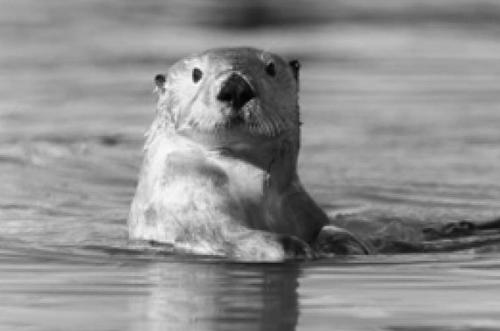What matters for sea otters’ prey perception 海獭靠什么感知猎物
蒋建平


在漆黑而嘈杂的海底世界,海洋哺乳动物海獭却可以非常迅速地捕捉猎物,它们依靠的是什么呢?
Sea otters are pretty small compared to other marine mammals(哺乳动物), which means that, despite their fur coats, they tend to lose heat quickly, and need lots of energy to keep up their body temperature.
“So they need to eat 25 percent of their body weight each day,” says Sarah McKay Strobel, a sensory ecologist at UC Santa Cruz. “But in order to eat that much food, it means sea otters need to find all that food.” She studied the otters senses, to solve the mystery of how theyre such efficient food catchers. Vision isnt reliable, she says—its pretty dark and muddy underwater, and crabs and other smaller animals tend to hide. Hearing is also tough for otters in the noisy underwater environment. And sniffings no good either. “When theyre underwater, theyre holding their breath.”
Whats left is touch. So Strobel measured the sensitivity of the otters paws and whiskers(須). She blindfolded an otter named Selka, then presented it with plastic plates carved with tiny grooves(沟槽). Selkas job was to select the plate with two-millimeter grooves, which shed been trained to associate with tasty food, instead of plates with differently sized grooves.
Turns out, Selka could tell even a quarter millimeter difference in the grooves with her paws—above and below water. “The fact that she was able to perform so well while moving extremely quickly I think is really interesting. It suggests that sea otters have very quick decision-making abilities and very quick sensory processing abilities, which makes sense when you think about the type of lifestyle they lead and how quickly they need to find food.”
For the record, humans can feel the difference, too, but it takes us 30 times longer, which might make sense. After all, we live in environments where touch is less important in a hunt than sight and sound.
1. Why do sea otters eat much food?
A. To stay warm.
B. To swim faster.
C. To keep their fur thick.
D. To satisfy their good appetites.
2. What does paragraph 3 mainly talk about?
A. The use of plastic plates.
B. An experiment on Selka.
C. An introduction to Selka.
D. The function of otters touch.
3. What did Strobel find about sea otters senses?
A. They have sharp vision.
B. They feature alert touch.
C. Their smell works very well.
D. Their hearing is very powerful.
4. What can be inferred about sea otters from the text?
A. They have enough food to eat.
B. Their whiskers work better than paws.
C. They are efficient decision-makers.
D. They respond very quickly in hunting.
Sentence for writing
Turns out, Selka could tell even a quarter millimeter difference in the grooves with her paws—above and below water.
【信息提取】Turns out为“It turns out that...”的变形,意为“结果……”。
【句式仿写】结果证明,他解决这个问题的方法非常高效。

